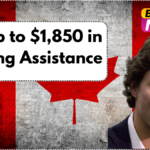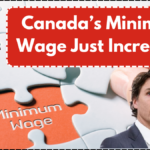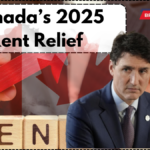In May 2025, the Canadian government is launching a one-time $430 rent relief payment to support financially vulnerable citizens amid escalating rental prices. This initiative, administered by the Canada Revenue Agency (CRA), aims to deliver direct assistance to seniors and low-income households disproportionately affected by Canada’s housing affordability crisis.
The payment is part of a broader strategy to alleviate immediate housing cost burdens while long-term housing reforms continue to evolve. As urban rent prices continue to rise, this measure provides a timely and targeted lifeline for eligible renters.

Why the $430 Rent Relief Payment is Critical
Rental markets across major Canadian cities have become increasingly unaffordable. For example, in May 2025, the average rent for a one-bedroom apartment in Vancouver stands at approximately $2,250, while Toronto’s average is near $2,100. These amounts are out of reach for many fixed-income seniors and working-class families.
The one-time $430 rent support isn’t just financial assistance; it represents a recognition by policymakers that many households are on the brink of displacement. With over 30% of income going towards housing in many cases, the relief payment offers a much-needed cushion.
Updated Eligibility Requirements for CRA’s $430 Rent Relief in 2025
To qualify for this benefit, applicants must meet the following criteria:
- Must be a Canadian citizen or permanent resident.
- Must be either aged 65 or older, or part of a low-income household.
- Must currently be renting a home or repaying a housing loan.
- Household income must fall between $33,000 and $37,240 annually.
- Must be enrolled in or eligible for housing support programs such as SAFER (Shelter Aid for Elderly Renters) or RAP (Rental Assistance Program).
Applicants are also advised to ensure their personal and banking details are current in their CRA online account to prevent delays in payment disbursement.
Enhancements to SAFER and RAP Programs in May 2025
Alongside the rent relief payment, the federal government has introduced key enhancements to two essential housing support programs:
- SAFER: Eligible seniors will now receive an additional $50 monthly to counteract ongoing rent increases.
- RAP: The Rental Assistance Program will adjust its regional payment benchmarks to better match local market conditions, ensuring that beneficiaries receive appropriate support.
Moreover, new awareness campaigns have been rolled out across TV, radio, and online platforms to ensure eligible individuals are fully informed.
Summary Table: $430 Rent Relief Canada 2025
| Category | Details |
|---|---|
| Payment Amount | $430 (One-Time) |
| Target Groups | Seniors and Low-Income Households |
| Program Connections | SAFER & RAP |
| Income Threshold | $33,000 to $37,240 Annual Household Income |
| Additional Monthly Support | SAFER: +$50/month |
| Required Documents | Proof of Rent, Income, ID |
| Application Platform | CRA Online Account or Provincial Housing Portals |
| Application Start Date | Late April 2025 |
| Disbursement Timeline | May to Early Summer 2025 |
How to Apply for Canada’s $430 Rent Relief
- Review Your Eligibility: Start by visiting the official CRA website or your provincial housing authority (e.g., BC Housing).
- Update CRA Account: Log into your account on Canada.ca and ensure your address and direct deposit information are accurate.
- Prepare Documents: Gather proof of rent payments, income verification, and valid ID.
- Submit Application: Complete the online form via the CRA or your provincial portal.
- Track Status: Use your CRA account to monitor application progress.
Applications are expected to open by late April 2025, with funds released beginning in May and continuing through the early summer months.
Government’s Broader Strategy for Housing Relief
The $430 rent payment is a short-term response within a larger national plan to tackle affordability challenges. In cities like Calgary, Ottawa, and Halifax, rent increases have outpaced inflation, pushing many households into financial hardship.
By offering this payment, the government aims to help renters avoid eviction or deeper financial distress while additional housing supply and affordability initiatives are underway.
Is the $430 Rent Relief Officially Confirmed?
As of mid-April 2025, the CRA has not published a formal announcement. However, provincial housing agencies and internal federal communications strongly indicate the payment will proceed. Final confirmation is expected on the CRA and respective provincial websites before the end of April.
Conclusion
The $430 rent relief payment is a timely measure to help those most affected by Canada’s housing affordability crisis. By targeting seniors and low-income households, the government is addressing the urgent needs of vulnerable communities. While it won’t solve the housing crisis, this initiative provides crucial breathing room as longer-term strategies are implemented.
FAQs About the $430 CRA Rent Relief Payment
Who is eligible for the $430 rent relief payment?
To qualify, you must be a Canadian citizen or permanent resident, aged 65 or older, or part of a low-income household earning between $33,000 and $37,240 annually, and currently paying rent or repaying a home loan.
How do I apply for the rent relief benefit?
You can apply via the CRA online portal or your provincial housing website. Ensure your personal information and bank details are updated before submitting your application.
When will payments be issued?
Disbursements are expected to begin in May 2025 and continue through early summer.
Do I need to be part of SAFER or RAP to apply?
No, but you must be eligible for one of these programs. Enrolment can strengthen your eligibility and potentially increase support.
Will this payment affect my taxes or other benefits?
The $430 payment is considered non-taxable and does not impact other federal or provincial benefits.
For More Information Click Here
Pari is a passionate writer known for captivating stories that blend imagination and reality. Inspired by travel, history, and everyday moments, Pari crafts narratives that resonate deeply with readers.




